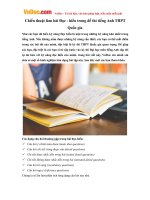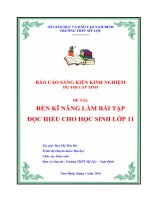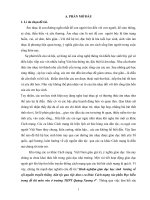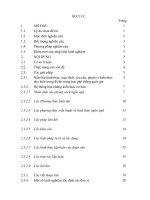57 CÁCH làm bài tập đọc HIỂU TRONG đề THI THPTQG
Bạn đang xem bản rút gọn của tài liệu. Xem và tải ngay bản đầy đủ của tài liệu tại đây (430.18 KB, 9 trang )
Chuyên đề:
CÁC KĨ NĂNG LÀM BÀI TẬP ĐỌC HIỂU TRONG ĐỀ
THI THPTQG
Compiled by Mrs Trang Anh
Facebook: Mrstranganh87
I. Các bước làm bài tập đọc hiểu trong bài thi THPTQG
1. Đọc câu hỏi trước, chưa vội đọc các lựa chọn trả lời. Vì khi đã biết được kiểu câu hỏi phải
trả lời thì sẽ dễ dàng tìm ra câu trả lời hơn.
2. Đọc kĩ mỗi câu hỏi và các phương án trả lời, gạch dưới mỗi từ khóa, tập trung vào các từ
khóa trong bài đọc để tìm ra câu trả lời.
3. Tùy vào từng kiểu câu hỏi để có các chiến lược làm khác nhau.
4. Không nhất thiết phải làm lần lượt từ đầu đến cuối, mà là câu nào dễ thì làm trước, câu khó
để lại sau cùng.
II. Các dạng câu hỏi thường gặp và cách làm
1. Câu hỏi về main ideas(ý tưởng chính của đoạn văn)
Nó sẽ thường bắt đầu bằng những câu hỏi như sau:
- What does the passage mainly discuss?
- What is the topic/subject of the passage?
- The author’s main purpose in the passage is to….
- What is the main topic of this passage?
- What is the best title for the passage?
- Where was the passage possibly taken from?
- What does the first/ second/ ... paragraph discuss?
- What is the purpose of the passage?
- The passage was written to ........
- The writer of this passage is trying to ......
- The most suitable title for the passage could be .........
- The passage mainly discusses ........
- The purpose of the passage is ..........
- The passage is intended to ........
=> Ý tưởng chính của đoạn văn thường tập trung ở phần đầu của đoạn văn, do đó chúng ta
nên tập trung vào phần đoạn văn đầu trong bài. Tuy nhiên, có những bài câu hỏi main ideas
được đặt xuống cuối trong thứ tự các câu hỏi của bài. Với trường hợp này, ý tưởng của đoạn
văn sẽ được rút ra từ việc hiểu nội dung của toàn bài. Do đó, câu này nên làm cuối cùng.
Ví dụ 1:
“Different cultures follow their own special customs when a child's baby teeth fall out. In
Korea, for example, they have the custom of throwing lost teeth up on the roof of a house.
According to tradition, a magpie will come and take the tooth. Later, the magpie will return
with a new tooth for the child. In other Asian countries, such as Japan and Vietnam, children
follow a similar tradition of throwing their lost teeth onto the roofs of houses.”
What is the passage mainly about?
A. Presents for young children’s lost teeth
B. Customs concerning children's new teeth
C. Animals eating children's lost teeth
D. traditions concerning children's lost teet
Ví dụ 2:
We get great pleasure from reading. The more advanced a man is, the greater delight he will
find in reading. The ordinary man may think that subjects like philosophy or science are very
difficult and that if philosophers and scientists read these subjects, it is not for pleasure. But
this is not true. The mathematician finds the same pleasure in his mathematics as the school
boy in an adventure story. For both, it is a play of the imagination, a mental recreation and
exercise.
What does the passage mainly discuss?
A. Different types of books
B. Different kinds of reading
C. Reading as an exercise for the brain
D. Reading as a pleasurable activity
2. Câu hỏi về stated details
- Các câu bắt đầu bằng: According to the passage, ....
- Các câu hỏi phủ định với NOT hoặc EXCEPT hoặc TRUE như:
Which of the following statements is NOT /TRUE according to the passage?
All of the followings are bees' main sources of food EXCEPT ......
=> Cách làm:
Khi gặp câu hỏi đọc tìm chi tiết, chúng ta thực hiện theo các bước sau:
Bước 1: Xác định keywords trong câu hỏi/ câu trả lời.
Bước 2: Đọc lướt để tìm keywords đã xác định ở bước 1.
Notes:
- Chỉ tập trung vào tìm "keywords".
- Lướt từng hàng của bài đọc và chỉ dừng lại khi phát hiện ra "keywords".
- Đôi khi không tìm được chính xác "keywords" mà có những từ/ cụm từ đồng nghĩa/ trái
nghĩa.
Bước 3: Dừng lại khi thấy "keywords".
Đọc kỹ thông tin trước và sau "keywords" xem nó có phục vụ cho việc trả lời câu hỏi không.
Nếu nó không liên quan đến câu hỏi, tiếp tục tìm lần lượt những chỗ mà keywords xuất hiện
cho đến khi tìm ra câu trả lời cho câu hỏi.
Ví dụ 3:
“ Birds aren't the only animals thought to take lost teeth. In Mexico and Spain, tradition says
a mouse takes a lost tooth and leaves some money. However, in Mongolia, dogs are
responsible for taking teeth away. Dogs are highly respected in Mongolian culture and are
considered guardian angels of the people. Tradition says that the new tooth will grow good
and strong if the baby tooth is fed to a guardian angel. Accordingly, parents in Mongolia will
put their child's lost tooth in a piece of meat and feed it to a dog.”
* According the passage, where is a child's lost tooth thought to be taken away by a mouse?
In Mongolia
B. In Korea
C. In Japan and Vietnam
D. In Mexico and Spain
Ví dụ 4:
Marriage was not so much a romantic love story but a business transaction, or deal. Most
marriages were arranged between parents while their children were still very young. It was
the custom that the fathers made the decision on whom their children were going to marry.
The mothers had little say in it since they rarely made any decisions outside the household.
The fathers would meet to arrange the wedding date and the money given for the bride on her
wedding date. The more money and land a girl had, the more chances she had to marry well.
Therefore, it was important that her father choose the bridegroom very well. Usually, it was
someone who came from a good family or who was rich too. It was very unlikely that people
married outside their social class.
The author mentions all of the following in the passage EXCEPT
A. People tended to marry outside their social class
B. Men made almost all decisions inside the family
C. Marriage used to be a deal between two families
D. The wedding date was decided by the fathers
3. Từ vựng trong văn cảnh
.
Một số câu hỏi tìm nghĩa của từ:
- What is the word/ phrase "abc" closest in meaning to?
- What does the word/ phrase "abc" most closely mean?
- The word/ phrase "abc" mostly means "............".
- The word/ phrase "abc" most likely means "............".
- The word/ phrase "abc" most closely means "............".
- The word/ phrase "abc" can be best replaced by "............".
=> Ý nghĩa của một từ có thể được xác định hoặc có thể dự đoán được:
TH1: Ý nghĩa của từ thường được gợi ý ngay trong bài bằng những từ đồng nghĩa hoặc cụm
từ giải thích từ đó.
TH2: Ý nghĩa của từ có thể được dự đoán thông qua ngữ cảnh của câu hoặc đoạn văn có từ
đó.
Cách làm:
+ Finding - Xác định vị trí từ vựng: thường thì từ vựng trong câu hỏi sẽ được in đậm trong
bài văn cho nên bạn sẽ không gặp khó khăn gì trong việc tìm kiếm chúng đâu.
+ Reading and Understanding – Đọc và hiểu: Dạng câu hỏi này thực sự đơn giản hơn nhiều
so với những dạng khác vì bạn chỉ cần đọc câu văn chứa từ vựng đó hoặc từ một đến hai câu
xung quanh để hiểu được ý nghĩa của từ vựng.
+ Eliminating or Choosing – Loại bỏ và Chọn lựa: Sau khi hiểu được ý nghĩa và sắc thái của
từ vựng, bạn có thể loại bỏ ngay những từ không phù hợp. Ví dụ từ vựng này mang nghĩa
tích cực thì hay gạch bỏ ngay những đáp án mang tính tiêu cực.
Một số chú ý khi đoán nghĩa của từ:
- Đôi khi người đọc có thể biết hết nghĩa của các từ được hỏi và của các đáp án đưa ra.
Tuy nhiên, cần đọc kỹ ngữ cảnh trước khi chọn câu trả lời vì một từ có thể có nhiều nghĩa
khác nhau trong những ngữ cảnh khác nhau.
- Nắm vững ý nghĩa của các tiền tố và hậu tố để có thể đoán nghĩa chính xác
Ví dụ 5:
when three young whales were trapped in the sea. It was close to winter and the sea had
begun to freeze over. Whales are mammals that require oxygen from the air, so the frozen ice
was a great danger to them. All they had then was a tiny hole in the ice for them to breathe
through. Volunteers from all over soon turned up to help these creatures. They cut holes in
the ice to provide more breathing holes for the whales. These holes would also serve as
guides for the whales so that they could swim to warmer waters.
The word “tiny” in paragraph 3 probably means___ .
A. very small
B. very deep
C. very fat
D. very ugly
Ví dụ 6:
The idea of giving lost teeth to an angel or fairy is also a tradition in the West. Many children in
Western countries count on the Tooth Fairy to leave money or presents in exchange for a tooth.
The exact origins of the Tooth Fairy are a mystery, although the story probably began in
England or Ireland centuries ago.
The word "origins" in paragraph 3 is closest in meaning to _
A. countries
B. families
C. beginnings
.
D. stories
4. Câu hỏi tìm mối liên hệ
Các loại câu hỏi đọc tìm mối liên hệ:
- What does the word "abc" refer to?
- The word "abc" refers to "............"
Cách làm:
Bước 1: Tìm từ liên hệ trong bài đọc.
Bước 2: Đọc kỹ thông tin trước và sau từ đó để tìm từ/cụm từ mà từ liên hệ có thể chỉ tới.
Những từ liên hệ thường nằm ở những câu phía trước.
Bước 3:
+ Tìm được từ/cụm từ đúng => chọn câu trả lời
+ Thử thay thế từ liên hệ bằng từ/cụm từ đã cho xem có hợp lý không.
Ví dụ 7:
“Marriage nowadays is a choice people make on their own, but this has not always been the
case in society. Thousands of years ago, the average lifespan was shorter than it is today. A
man usually lived until he was about 40 years old, while women died even sooner because of
childbirth. There were many wars and illnesses, and people had to protect themselves by
having more children while they were still young. The parents lived through their children.”
* The word "it" in paragraph 1 refers to
A. marriage
B. a choice
.
C. society
D. the average lifespan
Ví dụ 8:
Different cultures follow their own special customs when a child's baby teeth fall out. In
Korea, for example, they have the custom of throwing lost teeth up on the roof of a house.
According to tradition, a magpie will come and take the tooth. Later, the magpie will return
with a new tooth for the child. In other Asian countries, such as Japan and Vietnam, children
follow a similar tradition of throwing their lost teeth onto the roofs of houses.
The word "their" in paragraph 1 refers to
A. houses'
B. roofs'
.
C. children's
D. countries'
5. Câu hỏi suy ngẫm (inference and reasoning questions)
Các câu hỏi suy luận thường gặp trong bài tập đọc:
- What can be inferred from the passage?
- It can be inferred from the passage that ________.
- The passage/author implies that _________.
- Which of the following best describes the tone of the passage?
Đây là kỹ năng đọc hiểu khó nhất vì:
+ Yêu cầu người đọc rút ra kết luận dựa vào thông tin trong bài
+ Người đọc phải hiểu kỹ nội dung của bài đọc
+ Người đọc phải hiểu cả những ý sâu xa trong bài
=> Cách làm:
Để câu hỏi này làm cuối, sau khi đã hiểu ý tưởng chung của toàn bài sẽ dễ dàng tìm được câu trả
lời.
III. Các bài tập áp dụng
Overpopulation, the situation of having large numbers of people with too few resources and
too little space, is closely associated with poverty. It can result from high population density,
or from low amounts of resources, or from both. Excessively high population densities put
stress on available resources. Only a certain number of people can be supported on a given
area of land, and that number depends on how much food and other resources the land can
provide. In countries where people live primarily by means of simple farming, gardening,
herding, hunting, and gathering, even large areas of land can support only small numbers of
people because these labor intensive subsistence activities produce only small amounts of
food.
In developed countries such as the United States, Japan, and the countries of Western Europe,
overpopulation generally is not considered a major cause of poverty. These countries produce
large quantities of food through mechanized farming, which depends on commercial
fertilizers, large-scale irrigation, and agricultural machinery. This form of production
provides enough food to support the high densities of people in metropolitan areas.
A country’s level of poverty can depend greatly on its mix of population density and
agricultural productivity. Bangladesh, for example, has one of the world’s highest population
densities, with 1,147 persons per sq km. A large majority of the people of Bangladesh
engage in low – productivity manual farming, which contributes to the country's extremely
high level of poverty. Some of the smaller countries in Western Europe, such as the
Netherlands and Belgium, have high population densities as well. These countries practice
mechanized farming and are involved in high-tech industries, however, and therefore have
high standards of living.
At the other end of the spectrum, many countries in sub-Saharan Africa have population
densities of less than 30 persons per square km. Many people in these countries practice
manual subsistence farming; these countries also have infertile land, and lack the economic
resources and technology to boost productivity. As a consequence, these nations are very
poor. The United Slates has both relatively low population density and high agricultural
productivity; it is one of the world's wealthiest nations.
High birth rates contribute to overpopulation in many developing countries. Children are
assets to many poor families because the provide labor, usually for farming. Cultural norms
in traditionally rural societies commonly sanction the value of large families. Also, the
governments of developing countries often provide little or no support, financial or political,
for family planning; even people who wish to keep their families small have difficulty doing
so. For all these reasons, developing countries lend to have high rates of population growth.
Question 1: Which of the following is given a definition in paragraph 1?
A. Overpopulation
B. Population density
C. Simple farming
D. Poverty
Question 2: According to the passage, what will suffer when there are excessively high
population densities?
A. Available resources
B. Skilled labor
C. Farming methods
D. Land area
Question 3: The phrase "that number" in paragraph 1 refers to the number of
_______________
A. people
B. densities
C. resources
D. countries
Question 4: It can be inferred from the passage that In certain countries, large areas of land
can only yield small amounts of food because_______.
A. there is a lack of mechanization
B. there are small numbers of laborers
C there is on abundance of resources
D. there is no shortage of skilled labor
Question 5: According to the passage, Bangladesh is a country where the level of poverty
depends greatly on____________.
A. its population density only
B. both population density and agricultural productivity
C population density in metropolitan areas
D. its high agricultural productivity
Question 6: The word “infertile” in paragraph 4 probably means _________.
A. disused
B. impossible
C. unproductive
D. inaccessible
Question 7: Which of the following contributors to overpopulation in many developing
countries is TRUE according to the passage?
A. High-tech facilities
B. Economic resources
C. Sufficient financial support
D. High birth rate
Question 8: Which of the following could be the best title for the passage?
A. High Birth Rate and its Consequences
B. Overpopulation: A Cause of Poverty
C. Overpopulation: A Worldwide Problem
D. Poverty in Developing Countries









